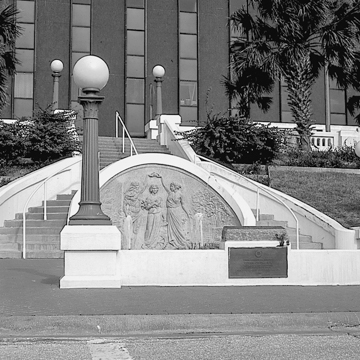The bluff, the singular, defining landmark in Corpus Christi, divides the central core of the city, literally and vertically, into uptown and downtown. Located four blocks west of the waterfront, the forty-foot-high bluff was enhanced in 1913 as part of a general civic infrastructure improvements program championed by then–newly elected mayor Roy Miller to signal Corpus Christi as the emerging city of the Gulf Coast.
Linked to other enhancements that included street paving, lighting, water mains, and the construction of a new courthouse ( CC9), the Broadway Bluffs improvements were designed by Potter, an internationally acclaimed park designer and civil engineer from New York City who was closely identified with the City Beautiful movement. Extending for six blocks, the improvements comprise segmental-arched retaining walls with a sloped, landscaped area traversed by sets of balustraded stairways connecting pedestrians to uptown and downtown. Two city thoroughfares, Upper and Lower Broadway, parallel the bluff and are, in turn, also connected to each other via vehicular ramps diagonally laid out along the slope.
Envisioned as a work of civic beauty, the project was embellished with a semicircular bas-relief sculpture and fountain, Queen of the Sea, by Italian immigrant sculptor Pompeo Luigi Coppini, who settled in San Antonio.















